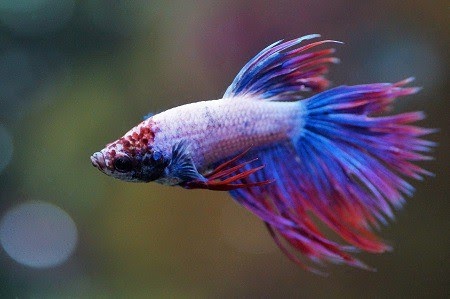Last Updated on October 6, 2020
If you have been wondering why your betta fish looks tired, unable to eat, and shows discolored fins, then it might be in need of a betta fin rot treatment.
Fin rot is a disease that is not only common in betta fishes but also in other types of fishes. The disease is caused by the Aeromonas, Pseudomonas, or Vibrio bacteria, and can be contagious if not treated. Although curable, you’ll have a hard time treating it if not prevented early on.
Today, we will take an in-depth discussion on treating fin rot on your betta fish. Though keep in mind that visiting your aquatic veterinarian is still advisable compared to treating your betta fish all by yourself.
Table of Contents
What does fin rot look like on a betta?

There are different stages of how a fin rot looks like on a betta fish. The first is the discoloration stage, where the fins look pale and lose their color. The discoloration will also depend on the color of your betta fish.
The second one called the fraying stage, where the fins start to “fray” and fall off piece by piece. The fins of your betta fish will now look uneven as if something is biting and tearing it off to pieces. The fraying happens gradually until there are no fins left to on the betta fish.
And lastly is the infection stage, where the fins have completely rotted away and the infection spreads on the body of the betta fish. During this stage, the chances of death are high since the bacteria is now starting to grow on the different parts of your betta fishes’ body.
What causes fin rot in betta?

The primary reason for fin rot is because of fish tanks that have poor water quality and non-optimal temperature levels. Bacteria buildup grows rapidly fast in fish tanks that have these characteristics.
Aside from an unclean fish tank, stress also plays a huge role for your betta fish to contract fin rot. Such stressors include overcrowding, decorations used on the fish tank, overfeeding, transferring from one fish tank to another more often, and feeding spoiled food.
Combining these stressors and an unmaintained dirty fish tank, the chances of your betta fish getting fin rot is high. Once your betta fish gets infected by the disease, not only it will make them look unattractive, but you are most likely to find them dead if left untreated for too long.
This is because your betta fish is using all of its energy to fight off the disease. This results in them losing their appetite during the infection stages, which then leads to their final resting place.
How to treat betta fish fin rot
Luckily, fin rot treatment is as easy as five steps. As long as you follow this guide we have given below, it will keep fin rot at bay in a matter of days.
Step 1: Be observant
The first step is to be observant. Check what are the causes of why your betta fish is sick. Channel your inner “Sherlock Holmes” and investigate your aquarium for any loose ends. Is it about water? The substrate? The foods you feed them? It could be anything!
You can also use an aquarium test kit to check its parameters for nitrate and pH levels. Lastly, take a look at its environmental factors as well such as sharp decorations, filter levels, or the materials of the ornaments on display.
These factors can stress up your betta fishes.
Step 2: Replace substrate
Now that you know the factors that caused your fishes’ health deteriorate, it’s time to remove those factors. A good example would be replacing your substrate with another gravel material or replacing plastic plants with genuine ones.
You can also create a complete overhaul of your betta fish tank, but choose the right material and avoid the ones you have that made your betta fish stressed. Buying a bigger fish tank is also advisable so your betta fish will have plenty of room to swim around and stay calm.
Step 3: Clean fish tank thoroughly
During the overhauling process, make sure to clean your fish tank inside and out. Ensure that not even a single spec of dirt lives on its walls and floor. Use aquarium cleaning kits and if your wallet allows.
You might also need to consider its placement. Place it somewhere in your home where it can get adequate sunlight. Keep it away from dust and dirt prone areas. Dust can accumulate on the air above and might fall on the surface of your betta fish tank.
Step 4: Consider medication
If things get worse, medication is your only option. There are medications available in pet stores that cure fin rot. We highly recommend using an antibiotic med such as Erythromycin.
But, if your betta fish has developed a fungal infection because of the disease, use antifungal treatments such as Methylene Blue. This will help prevent and stop fungi buildup in a matter of days. Using medication also prevents your fish from contracting other diseases.
Step 5: Keep your betta fish comfortable
Lastly, make your betta fish comfortable in its completely overhauled habitat. Keep in mind that some medications can lead to bad effects which makes it hard for them to breathe. For that, use a sponge filter or air stone to keep the water clean and oxygenated.
Make your betta fish happy by talking to them more often. Feed them with foods they like instead of just random fish food that you’ve seen on the pet store. Feeding them the right foods to eat plays a vital role in their health and nutrition.
Take care of your betta fish by showing your love to them through foods, communication, and aquarium maintenance. This will make them more comfortable and stress-free knowing that you have exerted effort in keeping them alive and well.
Related: How To Cure Betta Fish Ick The Right Way
How long does it take for fin rot to heal?

The recovery time of your betta fish’s fin rot depends on how severe it is. As mentioned earlier, the diseases have three different stages. It may take several days or even a week before your betta fish can fully recover from the disease.
During the healing stage, keep your betta fish’s environment clean to prevent fin rot from coming back.
Dirty water is the most common reason for fin rot buildup, so grab your organizer to remind yourself to replace your fish tank’s water on a weekly basis. You can also use a water conditioner to improve its quality.
When your betta fish has fully recovered from the disease, it will show no signs of symptoms and their appetite will be back to its normal state.
Its fins will grow and might show a different color. Your betta fish will also start to feel more alive by swimming and playing around the fish tank more actively than before.
Regularly maintain your betta fin rot treatment
Getting rid of fin rot is no easy feat. Prepare to do a lot of cleaning, replacing, and maintaining, which can take a toll on your wallet. But the aftermath is worth every dime and sweat you have sacrificed for it.
Let this be a reminder that regularly maintaining your betta fish tank is a must. By having a clean and healthy fish tank, your betta fish can grow and develop happily without contracting fin rot or any kind of disease.
